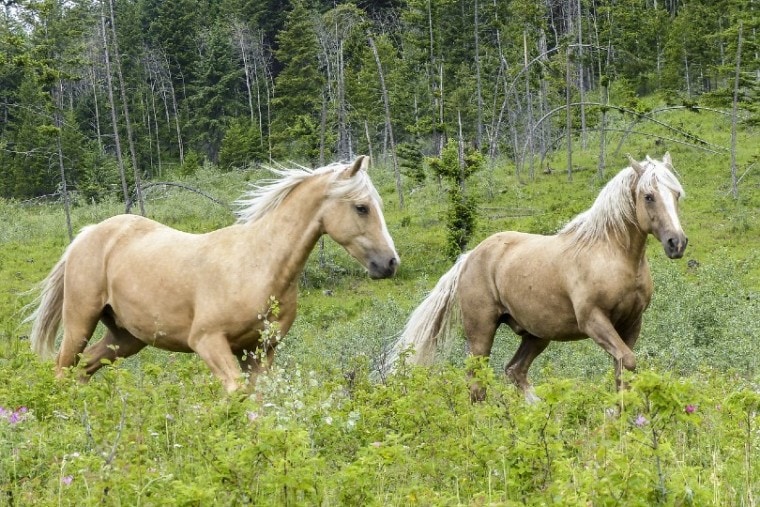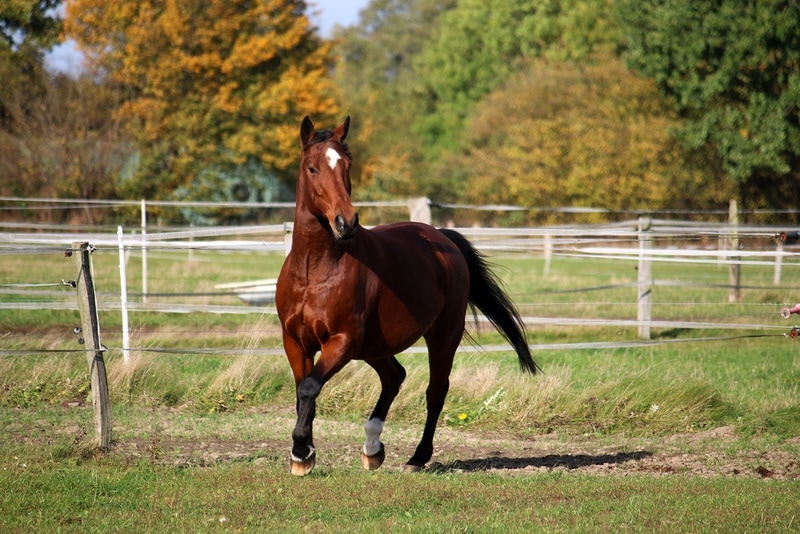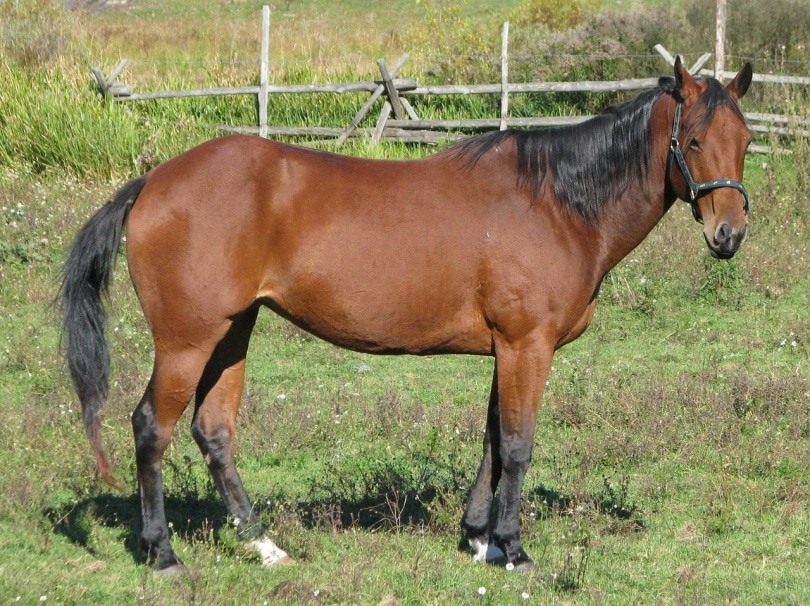
The Quarter Pony is a smaller variation of the quarter horse, but it can come in any combination of colors and color points. The pony originated from a time when Quarter Horses had minimum height requirements, and while these have now been phased out, the Quarter Pony still exists.
Ideal for smaller riders and those that don’t want to handle a larger animal, the breed is popular for riding, teaching, and some exhibitions. This variety of pony has the same care requirements as any pony, so they eat hay, require regular grooming, and need to be regularly vaccinated, wormed, and checked over by a vet.
Read on to find out more about caring for these animals and to see whether one is the right choice for you.
Quick Facts about Quarter Ponies
| Species Name: | Equus ferus caballus |
| Family: | Equidae |
| Care Level: | Moderate |
| Temperature: | Any |
| Temperament: | Gentle and agreeable |
| Color Form: | Any |
| Lifespan: | 25 – 35 years |
| Size: | Between 11.2 – 14.2 horse hands; Weighs roughly 900 pounds |
| Diet: | Grass, hay, grain, forage, salt block |
| Minimum Paddock Size: | ¾ acre |
| Stable Set-Up: | Water buckets, hay nets, feed buckets, rubber mats, manure |
Quarter Pony Overview
History
The Quarter Pony is a relatively new breed. It was developed for those steeds that did not meet the 14.2 hands requirement of the American Quarter Horse Association. Although the breed was developed using horses that were similar to Quarter Horses, there does not need to be any Quarter Horse in the pony’s genetic history.
Eventually, the American Quarter Horse Association removed its height requirement, but the development of the Quarter Pony breed continued.

Associations and Registries
The American Quarter Pony Association was formed in 1964 and allowed a wide range of horse and pony styles. Animals in the registry were getting taller, and so the National Quarter Pony Association was established, specifically targeting small quarter horse styles. The International Quarter Pony Association was established at around the same time.
There are approximately 3,000 Quarter Ponies registered with these organizations today.
If a pony is of Western type with unknown or unrecorded breeding, it is eligible for registration through a physical check. Those horses with recognized breeding and parents that are part of a recognized breed registry are automatically entitled to registration.
Characteristics
The Quarter Pony should measure between 11.2 and 14.2 hands. An average pony weighs approximately 900 pounds. Those at the higher end of the scale can be ridden by larger riders who do not want to tackle large horses, while the smaller Quarter Pony is considered ideal for the novice and small rider.
The pony is solid-looking and strong. It has an alert, broad head, small ears, and well-developed jaws. A medium-length neck reaches high shoulders to create a perfect saddleback. The broad-chested pony has strong, muscular rear quarters. Overall, the Quarter Pony’s appearance is one of a strong and muscular animal that is perfectly bred for riding.
Colors
Although initially the Quarter Pony was only recognized in solid colors, a variety of markings and patterns are now considered acceptable, and patterned ponies are readily accepted by registries.
How Much Do Quarter Ponies Cost?
Quarter horses can be expensive, but this depends on the size and breeding. Ponies, on the other hand, are less expensive. Expect to pay at least $1,000 for a recognized Quarter Pony, and if it has award-winning lineage, you could end up paying more.
The cost of purchasing the pony is only the beginning, however, and you will have to meet the ongoing costs of caring for your pony.
It is estimated that keeping a pony costs the equivalent of at least $5 per day or just over $1,800 per year, including food, farrier, and healthcare. Boarding can add another $1,000 or more to the annual bill.

Typical Behavior & Temperament
Ponies are not only smaller than horses, they tend to be less spirited and easier to manage, although there are always exceptions. The Quarter Pony is muscular and strong. It enjoys being ridden and tends to do very well in competition and exhibition, as well as being a useful pony for lessons. The breed is adaptable and does not usually mind being ridden by different people so it can make a good family ride or a good addition to a riding school.
As well as being small, this breed is preferred as a child’s horse because it is considered to be even mannered and gentle.
Appearance & Varieties
There is a lot of potential variation in Quarter Pony appearance. Generally, they will measure an average of 13.2 hands, but some breeders want larger animals that can measure as much as 14 hands and can be ridden by larger owners.
It has a broad head and small ears, wide eyes, and a neck at approximately 45° to the back.
The pony has sharp withers that stand medium-high from the back, and this gives a good saddle back. It has deep rear quarters that are heavily muscled. In fact, the overall look of the breed is muscular and strong, despite being smaller than the Quarter Horse after which it is modeled.
It is most common to see Quarter Ponies of a solid color. This is because the breed registries initially only accepted solid colors and would not accept color points or patterns. This has changed so that patterned ponies are now accepted. The number of patterned ponies is likely to continue to increase over time, but solid colors remain prevalent.

How to Take Care of Quarter Ponies
Stable Requirements
The recommended minimum size for a pony stable is 10’ x 10’, although if you can provide more space, your pony will appreciate it. For larger Quarter Ponies, you should provide 10’ x 12’. Height is also important and you must provide 3 feet of clearance above the pony’s head. Take beams and light fixtures into account when calculating headspace.
You should also take bedding into account when calculating height. Bed the stable down and then calculate size and space requirements because the room can seem much smaller.
You will need hay nets, feed buckets, and water buckets for your horse. If you are only providing the minimum amount of recommended space, wall-mounted nets and buckets are preferred because these will take up less floor space and your pony will still have ample room to move around.
Flooring should be stable and even and should be slanted to allow for the natural drainage of urine away from the horse. Bedding should cover the whole floor and usually be thicker around the stable door where a pony will spend a lot of time standing. A bare concrete floor causes stress on the joints and can lead to musculoskeletal complaints.
Ventilation must be offered year-round and can be achieved through the opening and closing of stable doors. You will, however, need additional ventilation from air vents and windows. A window is beneficial, especially because it allows natural lighting. While you can use acrylic, you should not install a glass window because shattered glass is dangerous.

Paddock Requirements
There is some debate over paddock requirements for horses and ponies. As a general rule, owners are told that a horse requires approximately 1 acre. However, you must take into account whether the horse will be living in or away from the paddock, whether it is sharing the paddock with others, and also the size of the horse in question. One acre should prove adequate for a single pony that is not sharing and whether it is living in the field or not.
Do Quarter Ponies Get Along with Other Pets?
The American Quarter Pony is a gentle and easygoing animal, and it will usually get along with all other animals. It will get along with dogs, although they should already know how to behave around horses before being introduced.
Horses and ponies, by nature, are sociable animals, which means that they will not only put up with other ponies but will benefit from the companionship.
Introducing a new pony to an existing herd can be done gradually. Keep the new horse within view but prevent your existing horses from being able to reach. Once they have had the opportunity to see and smell one another, they can be moved to neighboring paddocks so that the new horse and your existing stock can sniff one another but can still escape to the confines of an open field, if needed. Start with a gradual introduction of a few minutes at a time and increase this time.
Once the ponies are quiet and get along with one another when separated by a fence, you can gradually introduce them in the same field. Always keep a close eye on a first encounter. Just because the two of them got along well when in separate fields, it does not mean that they are guaranteed to bond when in the same field.

What to Feed Your Quarter Pony
Ponies eat a fraction of the amount of hay that horses do because they are a fraction of the weight.
Ensure you choose good quality grass hay. There’s no need to offer feed hay like alfalfa, and they may prove to be too rich for your pony.
Alternatively, you can allow your pony to graze on grass. Introduce it slowly and allow it to graze twice a day. Start with 10-minute grazing sessions and add 5 minutes every few days.
It is worth noting that some ponies may never be able to feed on rich grass, so you may have to feed hay instead.
While horses benefit from concentrates, ponies rarely need these. You can feed a small portion of grain on occasion, but, again, your pony’s stomach may say otherwise, and it may prove too rich a diet. Before adding a concentrate to your pony’s diet, try improving the quality of the hay first, and if you do find that you need to introduce a concentrate, ensure that it is low in calories to prevent an overweight pony.
Ponies also benefit from being given access to a salt lick. They need this mineral and rarely overindulge, consuming just the amount they require, so it should be safe to offer free access to a salt lick block.
Keeping Your Pony Healthy
There are various ways to help ensure a pony’s good health.
Grooming
Grooming not only helps maintain physical condition but allows you to regularly check your pony’s health. Allow 1 hour a week to thoroughly groom and maintain your Quarter Pony and look for flinching or signs of pain when you’re brushing.
Weight
Ponies are more prone to being overweight than horses, and this is a major cause of physical illness and poor shape. Ensure that you follow a good diet, provide your pony with 30 minutes of good exercise a day, 6 days a week.

Dental Hygiene
Check your pony’s teeth regularly and have a professional check-up done every 6 to 12 months. Domesticated horses do not grind their teeth down like wild ones, and poor dental hygiene can lead to nutrition and other problems.
Exercise
Ponies really do benefit from time outdoors and, if yours can stomach natural grazing, it may also benefit from being allowed to graze. This can help stimulate saliva which also keeps the stomach healthy.
Hoof Health
Hoof health is as important to ponies as horses. Ensure bedding is good quality, maintain bedding depth, and monitor drainage to make sure all urine and liquid escapes and is not left on the ground.
Breeding
Ponies may be smaller than horses, but they have a roughly similar gestation period. While a horse will be pregnant for an average of 340 days, a pony’s gestation lasts for 333 days, which is very similar.
Fillies reach sexual maturity at about 18 months of age and can start to reproduce at 2 years of age. Experts recommend that they be left until they are 4-5 years old, however, because they will have finished growing by this stage.
Ensure the mare is fed a good diet and be prepared to increase food throughout the stages of pregnancy. If you intend to breed a mare, have her checked out by a vet who will be able to tell you whether she is physically ready and whether there are any precautions that you should be aware of.
Are Quarter Ponies Suitable for You?
You do need a lot of space and time to keep Quarter Ponies. As a minimum, you should expect to ride or exercise your pony three times a week for 30 minutes a time. You should also offer an hour of grooming each week because this provides the social interaction that your pony craves and also enables you to check for signs of ill health or poor physical condition.
If you enjoy riding but are not keen on large rides, then a Quarter Pony is a good choice, because it enjoys being ridden and despite being smaller than a horse, it is strong and physically capable.
Featured Image Credit: ArtTower, Pixabay









